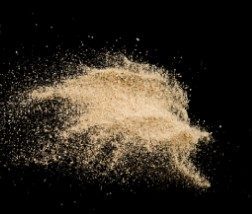
What is the difference between sandblasting and abrasive blasting? While both are commonly used, they are distinct and different processes that work best in different circumstances. To help you better understand your options and make the best decision for your project, here’s a look at sandblasting vs. abrasive.
With sandblasting, fine bits of material are propelled at extreme velocities so that a metal surface may be cleaned or etched. While sandblasting is the most common term to describe this process, materials other than sand can be used to do the cleaning and/or etching. In fact, because of health issues that sandblasting and the inhalation of sand dust can cause, many finishing operations now use alternate materials for their blasting — such as walnut shells, powder abrasives, steel grit, copper slag and others.
The sandblasting process is always carefully monitored, and those doing the sandblasting wear protective gear to prevent inhalation. When done properly, sandblasting is one of the most effective ways to clean and etch metal surfaces.
Abrasive blasting goes by many different names, including abrasive jet machining, pencil blasting, abrasive micro-blasting, micro-abrasive blasting and more. No matter the name, the process includes using gas to propel abrasive materials at high velocity to wear away the surfaces of particularly brittle, heat-sensitive, hard or thin materials. We most often see abrasive blasting used to form edges or to create shapes that are more intricate.
Which approach is best for your next project: sandblasting or abrasive blasting? The answer really depends on the project at hand and its unique requirements. For example, parts and surfaces that simply need cleaning or basic etching might do best with sandblasting. But, as noted above, specific types of material and the formation of more intricate shapes might require abrasive blasting.
At Finishing Systems, we’re always here to answer your questions related to sandblasting, abrasive blasting or finishing in general. If you’re curious which approach to blasting would work best for your surfaces and materials, you can always reach out to us for expert guidance as you consider your options.
Finishing Systems is your expert source for sandblasting and abrasive blasting, as well as answers to your questions about both approaches. Since 1972, we’ve been providing our diverse base of customers with innovative finishing services, including blasting and stripping, parts remanufacturing and assembly, packaging, distribution and warehousing. We always challenge ourselves to embrace new technology and industry innovations so that what we offer our customers represents the latest and greatest. If you have questions about sandblasting vs. abrasive blasting, we’re here to help.